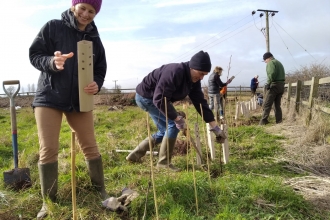
Wildflower verge at Whitchurch
Hedgerow Havens case study: Whitchurch wildflower verges
Maybe you’ve heard the buzz around wildflower road verges? With small changes to management, verges can become havens for wildlife, supporting hundreds of flowering plants along with insects, birds and mammals. Through our Hedgerow Havens project, we worked with councils, local wildlife groups and members of public in the villages of Whitchurch and Weedon near Aylesbury to establish wildflower road verges and show how small changes in management can bring big changes for wildlife.
The area selected in Whitchurch was a 400m2 plot set back from the main road. Until 2019, this area had been allowed to grow wild, becoming dominated by brambles and invasive weeds from the surrounding gardens. The parish council took steps to clear the area back, and then reached an agreement with BBOWT to manage the area for the benefit of wildlife over the next 25 years.
Over the spring and summer of 2019, steps were taken to remove the invasive garden plants which had invaded the site. After several visits by the Hedgerow Havens Project Officer, BBOWT trainees and local volunteers, the site was ready for seeding. This was carried out in July by volunteers from the Whitchurch Wildlife & Environment Group, Whitchurch parish, North Marston Wildlife & Environment Group and BBOWT.

Appreciating the verge in full bloom
The specially-selected meadow seed mix included species such as birds foot trefoil, ox-eye daisy and tufted vetch, and was sown along with a mix of cornfield annuals such as poppies, corncockle, chamomile and cornflower. These provide shelter and important nectar sources while longer-lived meadow species develop below.
By the autumn of 2019, the seeds had germinated and turned the area a pleasant light green, which remained the case throughout the winter months. In the early spring of 2020 the plants started to take off and grow taller before the first flowers - the distinctive blue florets of the cornflower - emerged in April, followed by the pink of corncockle, the white of chamomile and the red of poppies in May before finally the yellow of corn marigold arrived in June to kickstart the summer.
In July- August of 2020 the first hay cut was carried out by members of the Whitchurch Wildlife & Environment Group. In the years since, the group has continued to manage the verge through an annual hay cut, and an agreement between BBOWT and Whitchurch Parish Council means the verge will continue to be looked after this way until 2044 at least. We look forward to hearing how it develops.

Ox-eye daisy, red campion, meadow buttercup and wild carrot growing in May 2021 in a wildflower verge in Whitchurch established by BBOWT's Hedgerow Havens project. Picture: Caroline Heron



